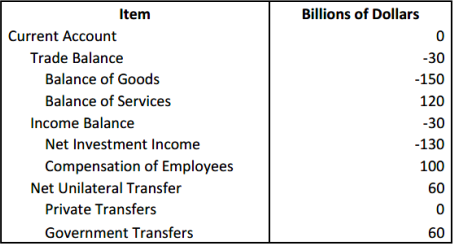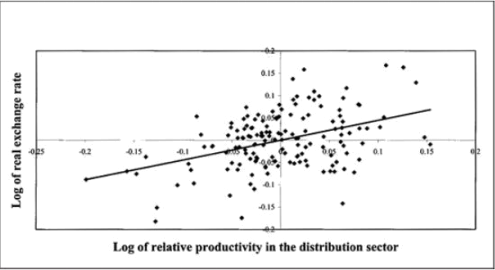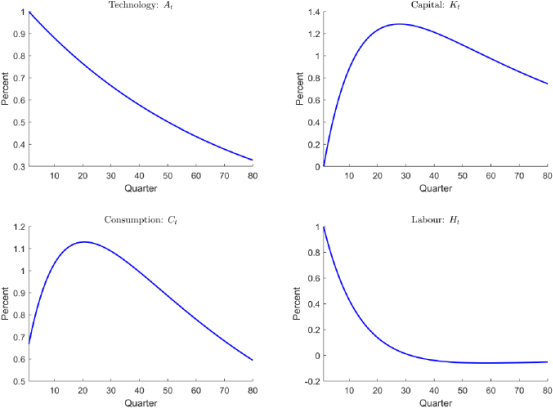EC201 – Macroeconomics 2
Hello, dear friend, you can consult us at any time if you have any questions, add WeChat: daixieit
EC201-Macroeconomics 2
Section A: Answer ALL questions on the QMP portal (20 marks in total)
Section B-Part I: Answer ONE question
11. Consider the following table. It describes the balance of payment of Pancraziland. All the numbers are denominated in US dollars. Describe very accurately what you can infer about the features of Pancraziland's economy and how it relates to the rest of the world. In addition, try to get a broad view of what this balance of payment suggests: given the information above, which type of economy do you envision Pancraziland to be? Is it small or big,why? Which could be the larger sectors? Which type of workers mostly work there? Etc.
Please keep your answer short and to the point. Unnecessarily long answers that include irrelevant information will be penalised. (10 marks)

12. Consider the following figure. The y-axis captures the log of the real exchange rate of a country with respect to the US (higher number implies more depreciation for that country), and the x-axis captures the log of productivity in the distribution sector of that country relative to the US. The distribution sector productivity is a good proxy for measuring how tradable goods are easily movable within, from, and to that country. Describe the link between the two variables by logically associating it to a model we studied in class and by highlighting the theoretical mechanisms behind it.
Please keep your answer short and to the point. Unnecessarily long answers that include irrelevant information will be penalised. (10 marks)

Section B- Part Il: Answer ONE question
13. Consider the following graphs which display the impulse responses of the RBC model. Describe the dynamics of the four variables and logically highlight the theoretical mechanisms behind them.
Please keep your answer short and to the point. Unnecessarily long answers that include irrelevant information will be penalised.(10 marks)

14. Consider the Solow model studied in the module. Describe what are the main assumptions in the Solow model and explain what is the research objective of the Solow model, what are its prediction and its validity.
Please keep your answer short and to the point. Unnecessarily long answers that include irrelevant information will be penalised.(10 marks)
Section C: Answer BOTH questions
15. Consider a two-period, small, open economy. Households are endowed with 10 units of tradables in period 1 and 11 units in period 2(Qar= 20 and Qzr=22). The country interest rate is 10 percent, or r=0.1, the nominal exchange rate is fixed and equal to 1 in both periods (S1= S₂=1),and the nominal wage equals 5.5 in both periods(Wi=W₂=11). Nominal wages are downwardly rigid.
Suppose the economy starts period 1 with no assets or debts carried over from the past
![]() . Suppose that the household's preferences are defined over consumption of tradable and non-tradable goods in periods 1 and 2, and are described by the following
. Suppose that the household's preferences are defined over consumption of tradable and non-tradable goods in periods 1 and 2, and are described by the following
utility function,

where Cir and Czr denote consumption of tradables in periods 1 and 2, respectively, and Civ and Czn denote consumption of non-tradables in periods 1 and 2. Let pi and pz denote the relative prices of non-tradables in terms of tradables in periods 1 and 2, respectively. Households supply inelastically h= 1 units of labour to the market each period. Finally, firms produce non-tradable goods using labour as the sole factor input. The production technology is given by

in periods 1 and 2, respectively, where Qiv and h;denote, respectively, non-tradable output and employment in period i=1,2.The parameter a is equal to 0.5.
(a) Assume that, in any circumstances, the sum of labour income and profit for firms that the households get from the non-tradable sector are equal to the endowment of non- tradable in each period.[This assumption turns out to be true]. This means that in
addition to Qr, the households obtain Qwin each period i=1,2.
Also, notice that the market of non-tradable good must clear every period.
Given the information above, write down the intertemporal budget constraint in terms of tradable goods.(3 marks)
(b) Derive the optimal consumption of tradable in period 1 and in period 2. Given the optimal consumptions, what is the trade-balance in the two periods? Provide an intuition for the result.(5 marks)
(c) We are now looking for the equilibrium level of employment in period 1 h Let us start from the demand side. Assume that the price of foreign tradable goods is normalized to 1 and that the law of one price holds,i.e. Pr = Sin period i=1,2.The revenue for the non-tradable goods firms in terms of tradable goods is p:F(h,) while its cost ![]() in period i=1,2.Write down the firm problem in period 1 and derive the labour demand equation of the firm, which is a relationship between p₁ and hi.
in period i=1,2.Write down the firm problem in period 1 and derive the labour demand equation of the firm, which is a relationship between p₁ and hi.
Let us now derive the demand schedule for non-tradable for the household in period 1. To do so, first, find out the household's optimality condition that links consumption of
tradable and non-tradable in period 1; second, use the fact that the consumption of non-tradable clears in each period, that is C₁n=F(h₁),and also use the equilibrium value of Cir found above. This will give you another relationship between pi and h₁.
Use the two equations found in the previous steps to determine the equilibrium level of employment in period 1,hi, and the non-tradable output produced in period 1, Q₁v. (8 marks)
(d)Now assume that instead the interest rate is 20 percent. Recompute optimal non-tradable consumption in the two periods, the trade-balance, the equilibrium level of employment in period 1, and the non-tradable production in period 1.Provide an intuition for the results in how they differ from the case where the interest rate is 10 percent. (8 marks)
(e)Still assume the interest rate is 20 percent. What is the devaluation rate of the currency that the country should set to obtain full employment? Explain your results. (6 marks)
16.Consider the RBC model with the following functional forms:

and recall that the budget constraint of the household can be written such that:

(a) Set up and solve the representative firm's profit maximization problem.(3 marks)
(b) Describe what is the problem of the households.(4 marks)
(c) Explain what is the meaning of the parameter a and how does the household react when σ<0,σ=0andσ>0 .(4 marks)
(d) Set up and derive the representative household's utility maximization problem, assuming perfect foresight.(5 marks)
(e)Suppose just for this sub-question that ψ=0, i.e. the household does not care about consumption. How does ht respond to a positive technology shock in this case? Is this consistent with what we see in the data?(4 marks)
(f) Suppose now that θ=0, i.e. the household does not care about leisure. How does ht respond to a positive technology shock in this case? Is this consistent with what we see in the data?(3 marks)
Suppose now thatθ=0 andδ=1.Moreover, assume that σ= 1, which implies that the Euler equation becomes:
Ct=(1-aβ)Y
(You do not need to derive this result.)
(g)Write down the new system of equations (the set of equations needed to solve the RBC model) in steady-state.(2 marks)
(h) Write one expression for capital and one for output in the steady state, K'and Y',as a function of exogenous parameters only.(5 marks)
2023-08-28